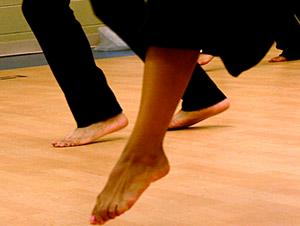A dancer’s remarkable journey
(Image by Flickr user Steven Depolo (cc: by-nc-sa))
This story is adapted from a broadcast audio segment; use audio player to listen to story in its entirety.
Some artists need only one name. Yuriko is one of them.
She performed with modern dance legend Martha Graham for twenty-three years. She created a role in the original “Appalachian Spring,” and she became world famous dancing the role of Eliza, on screen and in the original stage production of “The King and I.”
Yuriko, who turned 90 this month, hasn’t slowed down — even though she took a serious fall last year. Born in America, she spent her childhood in Japan where she started dancing professionally when she was just 10 years old. At 22, she was back in the US, in California at the start of WWII.
Yuriko and her family were interned with other Japanese-Americans in Arizona during the war. But it was there, Yuriko says, that to save her sanity, she talked her way into teaching dance.
Yuriko recently spoke to students at The Boston Conservatory, where she took some time to explain her remarkable journey and her reputation as a risk-taker.
“Well, you have to take the risk, in a sense that when something comes your way, you have to just instinctively take it or you are not going to take it,” she said. “I always took it, took the chance.”
The one thing that Yuriko was always sure of was that she wanted to be a dancer. This drive followed her, when she was in her 20s, into the internment camps.
“I’d been in the camp for I don’t know how long, but I was worried about my future career, and it just got to me,” Yuriko said. “I had a little nervous breakdown. I was sent to a hospital and came out the next day. Making a long story short, I just didn’t want to waste my energy not doing anything and I thought, ‘Maybe I know a little bit about dance. Maybe I should open up a studio.’ So, I went to the administration, and asked for a studio space. They gave it to me.”
Yuriko looks back at that period in her life as transformative. “It was one of the passages that was meant to be, for me, because that brought me to New York much sooner. I wanted to come but I didn’t have the money.”
In 1943, after eighteen months in the internment camp, she was given the permission to go, a one-way ticket, one suit, and $25 from the government. She had also saved some of the money she had earned teaching dance at the camp. The pay was $19 each month, making her total fund for the journey $100.
Her supervisor from the camp met her at the train station in New York and gave her a job as a seamstress. With a job in place, she was now able to pursue dance.
Since Martha Graham was the nearest teacher, Yuriko battled her own reluctance and went to Graham first. “You see, it is a Japanese way that you don’t go to a master right away,” she explained.
Within nine months of arriving in New York, Yuriko was a member of the Martha Graham Dance Company, and soon she was in the first production of “Appalachian Spring.”
“Here and Now” is an essential midday news magazine for those who want the latest news and expanded conversation on today’s hot-button topics: public affairs, foreign policy, science and technology, the arts and more. More “Here and Now”
